Plot
In a garden, a wind-up toy truck labelled under ACME Moving Co. pulls up to a mousehole door and two moving mice move the contents of the van into the hole. Afterwards, a young girl mouse and her parents move in. The girl mouse soon sees a boy mouse driving a motorized hot rod toy into his garage and walking up to his own mousehole. When he sees her, the boy mouse instantly falls head over heels in love. He quickly empties his sugar bowl of the one sugar cube in it and takes the empty bowl over to the girl mouse's home. However, Claude Cat sees him and tries to eat the boy mouse, but he escapes back to his mousehole. Claude tries to grab him but ends up getting his hand caught in a mousetrap.
Later on, the boy mouse tries using a pipeline to sneak past Claude but the cat takes a doll house front door, puts it over his own mouth and places himself at the end of the pipeline. The mouse, with an empty jug in hand, unknowingly enters and travels down into Claude's stomach where he lights a match. The flame causes Claude to jump in pain and the mouse to escape simultaneously.
Later, Claude observes the two lovers and gets an idea to entrap the boy mouse. Claude writes a fake letter to the boy mouse that reads "Dear Mister Mouse, I am in my teens - sixteen months - and deemed not unattractive by my friends. Can you meet me at eight tonight under the garbage disposal? yours (?) Alice (the girl across the way)" and sprays some perfume on it for good measure. Claude sends the fake letter to the boy mouse who, upon reading it, falls over in lust. By 7:55pm, the boy mouse drives to the trash can in the kitchen where he meets what he thinks is the girl mouse but is really a puppet being used by Claude to ensnare him. Upon seeing Claude, the boy mouse escapes with the puppet and knocks Claude out with the trash can lid.
As the boy mouse sighs over both his failure and being deceived with the puppet, Claude writes another fake letter, this time sending it to the girl mouse's father. The letter itself delivers a warning apparently from the boy mouse that reads, "Look you! I saw that apartment first, so get out - because I'm moving in!! The mouse across the way - P.S. or else!!" The father mouse promptly grabs a revolver as if to say "we'll see about that!" while outside Claude puts out a sign that reads "Boarder Wanted" and gets the boy mouse's attention to it. Upon seeing it, the boy mouse packs his things and moves in. Claude positions himself so that he catches the fleeing boy mouse in his mouth, but his plan simultaneously succeeds when the boy mouse runs into his mouth and backfires when the father mouse shoots him in the face, allowing the boy mouse to escape.
Determined not to let Claude get the better of him again, the boy mouse writes a fake letter of his own and sends it to him. The letter this time reads, "Dear Cat (Pal) I've decided to give up my evil ways and be nice to you. Yours in Friendship, The Dog - P.S. How's about coming over for a game of Canasta?" Claude falls for it and gets a huge beating from Hector (here named Butcher) when he tries to go over to his kennel for a card game. Meanwhile, the two young mice, having gotten Claude out of the way, raid the fridge and sip on some soda as the cartoon ends (with a heart-shaped iris out).
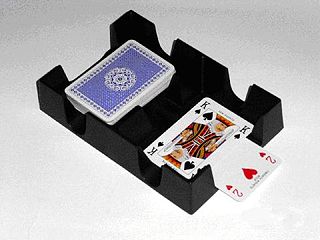
Canasta is a card game of the rummy family of games believed to be a variant of 500 Rum. Although many variations exist for two, three, five or six players, it is most commonly played by four in two partnerships with two standard decks of cards. Players attempt to make melds of seven cards of the same rank and "go out" by playing all cards in their hand. It is the only partnership member of the family of Rummy games to achieve the status of a classic.
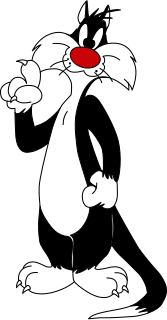
Sylvester J. Pussycat Sr., usually called Sylvester, is a fictional character, a three-time Academy Award-winning anthropomorphic Tuxedo cat in the Looney Tunes and Merrie Melodies series of cartoons. Most of his appearances have him often chasing Tweety Bird, Speedy Gonzales, or Hippety Hopper. Sylvester appeared in 103 cartoons in the golden age of American animation, only behind Bugs Bunny, Porky Pig, and Daffy Duck. Three of his cartoons won Academy Awards, the most for any starring Looney Tunes character: they are Tweetie Pie, Speedy Gonzales, and Birds Anonymous.

Scaredy Cat is a 1948 Merrie Melodies cartoon directed by Chuck Jones.
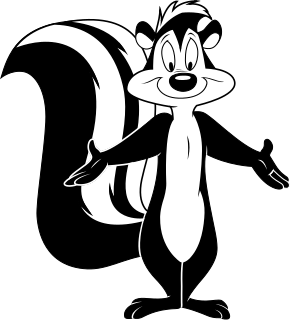
Pepé Le Pew is a character from the Warner Bros. Looney Tunes and Merrie Melodies series of cartoons, first introduced in 1945. Depicted as a French striped skunk, Pepé is constantly in search of love and appreciation. However, his offensive skunk odor and his aggressive pursuit of romance typically cause other characters to run from him.

The Yankee Doodle Mouse is a 1943 American one-reel animated cartoon in Technicolor. It is the eleventh Tom and Jerry short produced by Fred Quimby, and directed by William Hanna and Joseph Barbera, with musical supervision by Scott Bradley and animation by Irven Spence, Pete Burness, Kenneth Muse and George Gordon. Jack Zander was credited on the original print, but his credit was omitted in the 1950 reissue. It was released to theaters on June 26, 1943 by Metro-Goldwyn Mayer. The short features Tom the cat and Jerry the mouse chasing each other in a pseudo-warfare style, and makes numerous references to World War II technology such as jeeps and dive bombers. The Yankee Doodle Mouse won the 1943 Oscar for Best Animated Short Film, making it the first of seven Tom and Jerry cartoons to receive this distinction.

Mouse Trouble is a 1944 American one-reel animated cartoon short and is the 17th Tom and Jerry short produced by Fred Quimby. It was directed by William Hanna and Joseph Barbera, with music direction by Scott Bradley The cartoon was animated by Ray Patterson, Irven Spence, Ken Muse and Pete Burness. Mouse Trouble won the 1944 Oscar for Best Animated Short Film, the second consecutive award bestowed upon the series. It was released in theatres on November 23, 1944 by Metro-Goldwyn Mayer and reissued on December 12, 1951.

Mouse in Manhattan is a 1945 one-reel animated cartoon and is the 19th Tom and Jerry short released in American theaters on July 7, 1945 and reissued on February 28, 1953. Unlike other cartoons featuring the duo, this one focuses almost entirely on Jerry while Tom has a very minor role.

Kitty Foiled is a 1948 one-reel animated cartoon, the 34th in the Tom and Jerry series. It was created in 1947, and released in 1948. The cartoon was produced by Fred Quimby and directed by William Hanna and Joseph Barbera, with animation by Irven Spence, Kenneth Muse, Irving Levine and Ed Barge. The music was scored by Scott Bradley. This cartoon follows the canary bird named Cuckoo who helps Jerry from Tom.

Cheese Chasers is a 1951 Merrie Melodies cartoon directed by Chuck Jones, and starring Hubie and Bertie, as well as an appearance by Claude Cat. Mel Blanc plays Claude, Hubie and the dog; while Stan Freberg plays Bertie.

Tom and Chérie is a 1955 one reel animated Tom and Jerry short directed by William Hanna and Joseph Barbera and produced by Fred Quimby with music by Scott Bradley. It was the third cartoons in the Mouseketeer series of cartoons to take place in France, the first of which, The Two Mouseketeers (1952) won an Academy Award, and the second, Touché, Pussy Cat! (1954) received an Academy Award nomination. Chérie is not only a word play of Jerry in Tom and Jerry but also means "sweetheart" in French.

Little School Mouse is a 1954 the 83rd one-reel animated Tom and Jerry short, directed by William Hanna and Joseph Barbera and produced by Fred Quimby with music by Scott Bradley. The cartoon was animated by Irven Spence and Ed Barge, with backgrounds by Robert Gentle, and released on May 29, 1954 by Metro-Goldwyn-Mayer.

The Brothers Carry-Mouse-Off is a 1965 Tom and Jerry cartoon. The cartoon was directed by Jim Pabian, with animation by Tom Ray, Dick Thompson, Ben Washam, Ken Harris and Don Towsley. Eugene Poddany scored the music, while Maurice Noble provided layouts, and Robert Gribbroek did the backgrounds. The title, The Brothers Carry-Mouse-Off is a parody of the title of Fyodor Dostoevsky's novel The Brothers Karamazov, published in 1880.
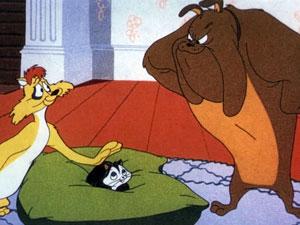
Feline Frame-Up is an animated short film in the Looney Tunes series produced by Warner Bros. Cartoons, Inc and released on February 13, 1954.
Chow Hound is a Looney Tunes animated short directed by Chuck Jones and written by Michael Maltese. Released June 16, 1951, the voices are performed by Mel Blanc, Bea Benaderet and John T. Smith.

Mouse Wreckers is a 1949 Looney Tunes short directed by Chuck Jones, starring Hubie and Bertie in their first pairing with the redesigned Claude Cat. The short centers around Hubie and Bertie's attempts to move into a new home by chasing Claude out of the home. Mel Blanc voices Bertie and an uncredited Stan Freberg voices Hubie. The title is a pun on house wrecker or home wrecker, where a house is destroyed, often figuratively, by a single person. Mouse Wreckers was nominated for Academy Award for Best Animated Short Film for 1948, but lost to The Little Orphan, a Tom and Jerry cartoon which was the fifth Oscar given to the cat and mouse team.
Little Red Rodent Hood is a 1952 animated short featuring Sylvester in parody of "Little Red Riding Hood".

Terrier-Stricken is a Merrie Melodies cartoon short, released in 1952, which was written by Michael Maltese and directed by Chuck Jones.

Mexican Boarders is a 1962 Looney Tunes cartoon short directed by Friz Freleng. Voice actors are Mel Blanc, and Daws Butler as the narrator.
Goldimouse and the Three Cats is a 1960 Looney Tunes fairy tale animated cartoon released on March 15, 1960. It is one of the few cartoons where storyboard man Michael Maltese did the storylines for cartoons from the Freleng unit for the first time since the late 1940s, the only Freleng-directed Sylvester cartoon to costar Sylvester Jr. and one of two cartoons where Sylvester is married.
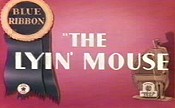
The Lyin' Mouse is a 1937 Merrie Melodies cartoon directed by Friz Freleng.


















